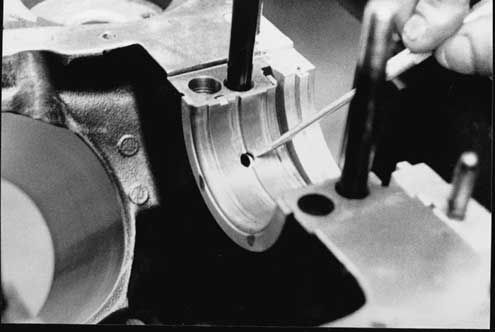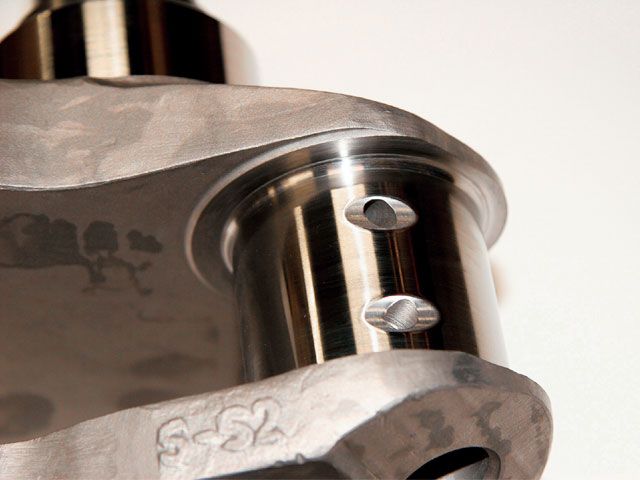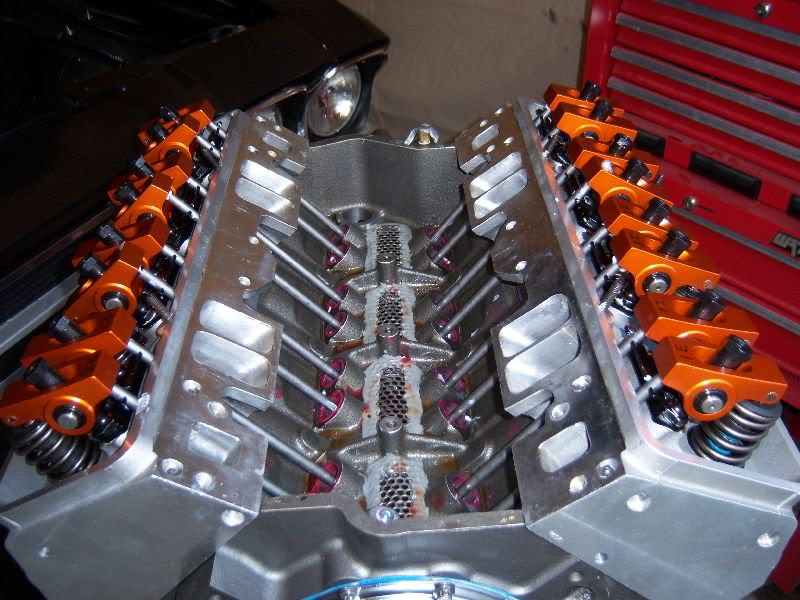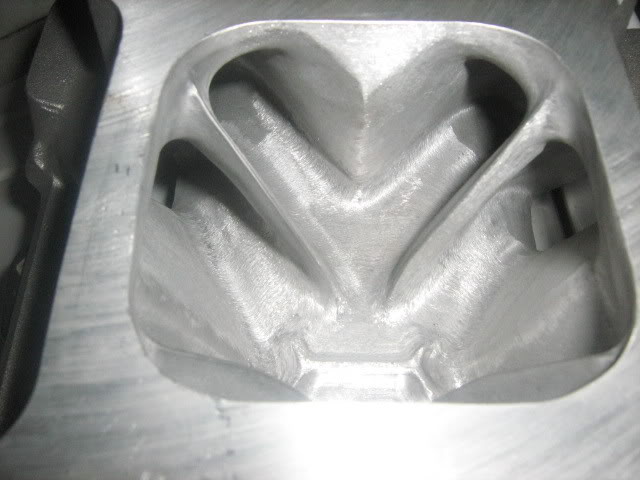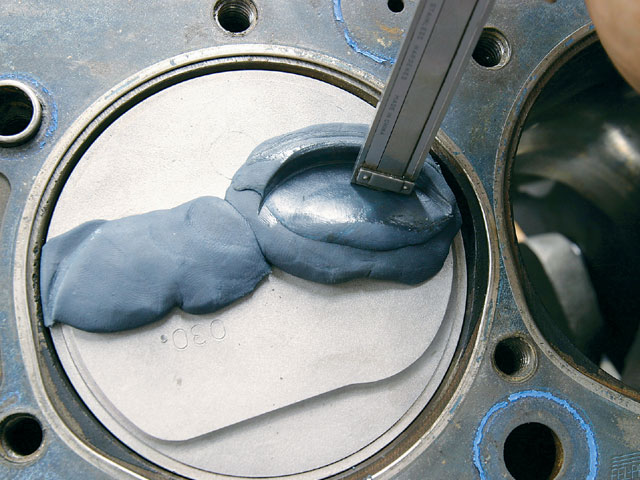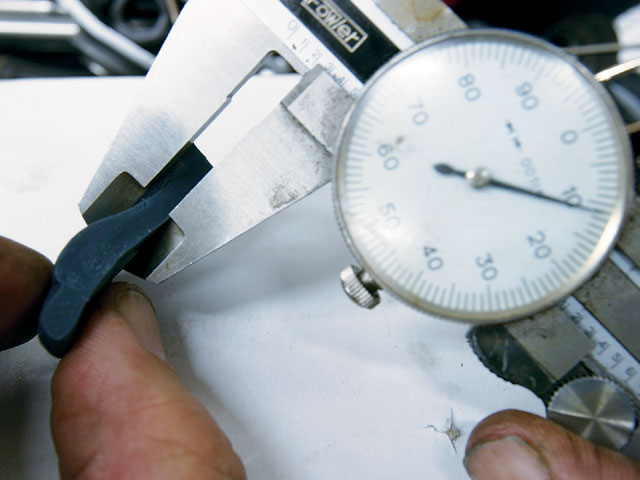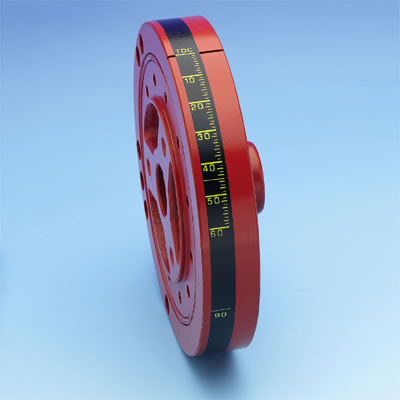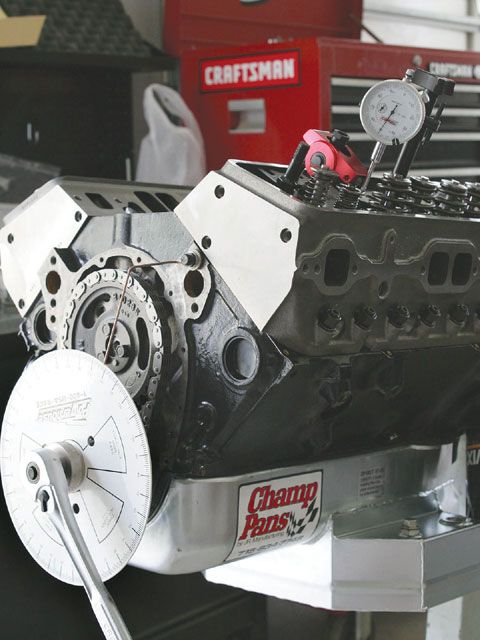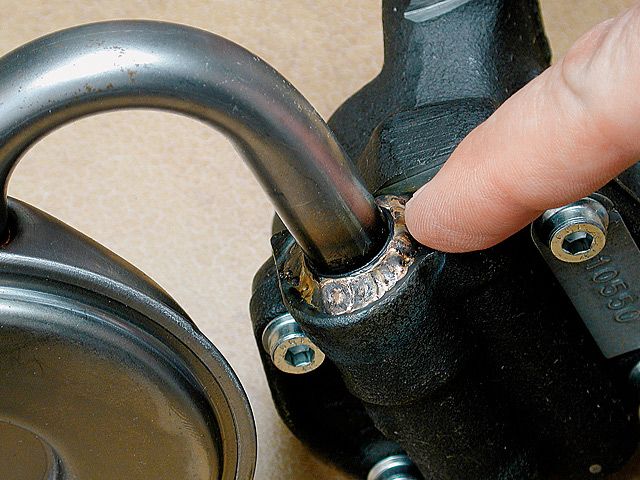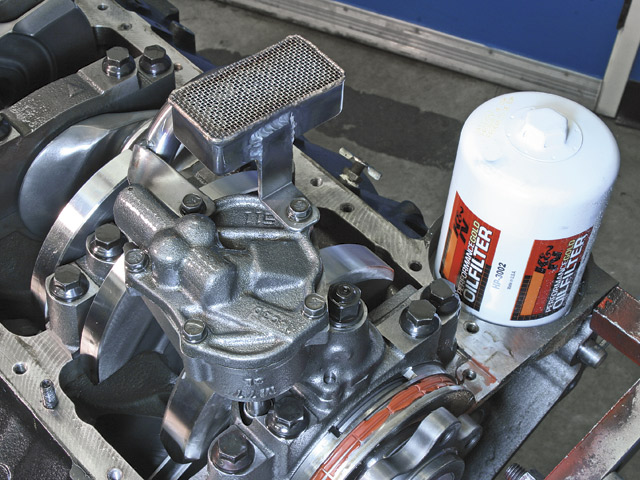http://www.dragzine.com/tech-stories/en ... ck-part-1/
http://www.dragzine.com/tech-stories/en ... ck-part-2/
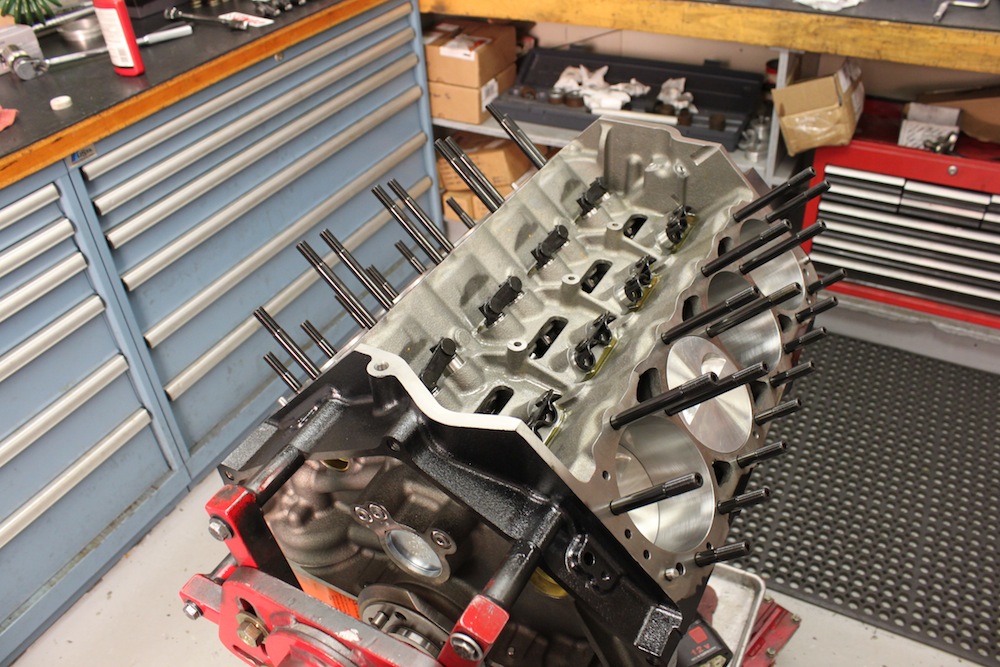
We needed a dyno mule to use and abuse for all the hardcore testing that you have come to love powerTV for. When a new head or camshaft profile comes on the market boasting monster power gains, we want to test it so you don’t risk your hard-earned dollars on stuff that may or may not work for your application. We knew we needed a capable engine that has the cheese to get it done and be reliable. The decision was made — a Dart SHP (Special High Performance) cast iron small-block Chevy block was ordered and spec’d for whipping-boy duty on the dyno. This motor is going to lead a rough life of cam swaps, cylinder head shootouts, and several hundred cubic miles of nitrous fogged into those cylinder bores, so it has to be stout.
The Dart SHP is based on the small block Chevrolet engine, but any time the term “small block†is mentioned, the first thing you think of is the classic 350. It has been ingrained into our oil-soaked gearhead minds that a “small block†is 350cui and smaller (with the exception of the 400 small block) and a “big block†is anything 396 and bigger, so say the gods of 1970. As time marches on, those definitions have changed.
Bigger Is Better
Custom engine blocks designed on the classic SBC architecture are getting bigger and bigger, to the point that the lines are seriously blurred, if not all-together broken. The OEMs have pretty much given up the big versus small classification, they are mostly based on the same architecture with different sized parts, and the LS7 is still considered a “small block†at 427 cubic inches. These days, you can build a 450-plus-cubic inch engine and still get away with calling it a small block.
The Dart SHP block has 4-bolt mains with splayed outer bolts to keep the main caps tight and to help eliminate cap walk.
The idea behind going big is an age-old adage, there are countless clichés that bring this home, but the reality of it is this: to make big power, you need a solid platform. Generating 500 horsepower from a 350cui engine requires 1.428 horsepower per cubic inch.
While this is easy with forced induction, getting there in a naturally aspirated design is more complicated, everything has to work just right. Increase the cubic inches to 440, and you cut that horsepower per cubic inch marker down to 1.136, which is certainly more easily attainable.
Additionally, you have more power potential when you start with a bigger base. If you want to fill a bathtub with water would you rather use a bucket or a Dixie cup? This is a bigger bucket. You wouldn’t test cylinder heads that can support 600 horsepower on a 350hp engine would you? The base platform can’t support the heads, it becomes a bottleneck, and in fact, can hurt the overall power potential. The same goes for camshafts and intakes. For a test mule, you need big power potential and stone-cold reliability.
So how do we do it? First, we needed to decide what our base power range is going to be. It takes power to make power, so it has to be big enough to support just about anything we can throw at it. Our base goal was set at 550hp with comparable torque numbers, but it has to do it on pump gas and with a hydraulic roller camshaft. Will our SBC ever see race gas? Undoubtedly. Is it conceivable that a solid roller bumpstick be slid between the lifters? Most likely, but the point here is to start with a high-powered real-world platform that can be built on.
A Firm Foundation
We decided to go big, beyond the typical standards for a small block, and that meant 440 cubes. To get there, we started with a Dart’s SHP block. The blocks are available in 4†and 4.125†bores, but we opted to go a touch bigger with a finished bore size of 4.185-inches. To get this big, the cylinders are siamesed, which means that they share a common wall; there is no water jacket between them. This not only allows for a little more bore in the same dimensions, but also strengthens the block, as there is not a large space between each cylinder. The cylinder walls can be cast thicker, which eliminates distortion under heavy loads and that is always a good thing.
The Dart SHP block has several key features that make it the perfect choice for our dyno mule, specifically the aforementioned siamesed cylinders, splayed 4-bolt main caps, and priority oiling. The main caps are “splayed,†which means that the outer bolts are layed over at an angle. This provides outward pressure on the cap, which keeps it in position, as well as preventing cracking at the webbing, which was a problem with standard 4-bolt mains. Under heavy loads, especially at higher RPM, main caps can walk forward/backward and side/side, even though they are torqued to spec.
Splaying the outer bolts pulls the cap outward towards the block, helping to lock it in place, making the crank and subsequently the rotating assembly more stable. Priority oiling sends the oil to the main bearings before it is directed to the cam bearings and valve train. This is critical for high-RPM engines that have more stress on the bottom end. The factory blocks were not designed for racing, Dart blocks are.
This sets up the Dart SHP to be a solid foundation for our mule. As with all the Dart blocks, the SHP was CNC machined to exacting tolerances; each operation is performed in-house to ensure perfection. The cylinder decks were squared and paralleled, the lifter bores, camshaft and main bearing journals finish machined to the required spec. The Dart SHP small-block employs 350 SBC main journals and cam journals, so you can use any SBC crankshaft and cam. It also has provisions for OE style roller lifters and cams and all the factory bolt holes for the starter, clutch ball, etc, so this block can bolt right in to anything a stock SBC can. The standard deck height on the SHP block is 9.025â€, but the as-shipped (unmachined) deck surface is .005-.010†taller so there is material available for final surface machining.
See your ad here
Parts is Parts
Dart SHP block, 4.185 bore
Lunati Pro Series forged stroker crank (AO211DN)
Lunati H-beam 6″ rods (6000H)
Clevite bearings (CB663P)
Moroso oil pan (24350)
Moroso dipstick (25970)
Moroso standard volume & pressure oil pump (63845)
Moroso oi pick up (24351)
KB ICON forged flat-top pistons (IC755KTD-060)
Total Seal rings (2559XC)
ATI SBC Super Damper (917411)
Comp Cams two-piece timing cover (210)
ARP hardware
Comp Cams double roller timing chain (3030)
Comp hydraulic roller camshaft (custom)
Comp Cams hydraulic roller lifters (850-16)
The Sum of Its Parts
When you are working with lofty power potential such as this, the bottom end needs to be tough, so each piece of the rotating assembly was made of forged steel. With a standard stroke (3.48â€) SBC crank, this would come out to 383, but the powerTV Dart engine is being saddled with a Lunati Pro Series forged stroker crank (AO211DN) with a 4†stroke, which gives us the 440 cubic inches of test mule bliss we were after. This crank weighs in at 50-52 lbs. and is forged from 4340 steel. The 4340 alloy meets the highest standards for aircraft quality, so it will be right at home in the 440.
The tolerances on the Lunati crank are quite strict; the shaft finish is 5 RMS or better, each journal radii is ground to .140â€, roundness of each journal is .0001†or less and each journal is cross drilled to lighten the rotating mass. This crank is good for 1500hp, so our baseline of 550 should not be an issue. For the rods, we went with a set of Lunati 6†forged steel I-beams.
The longer 6†rod provides a better rod-to-stroke ratio when combined with the 4†stroke than a standard SBC 350 5.7†rod. A low rod-to-stroke ratio increases side loading of the piston. At lower RPMs, below about 5500, you won’t notice much, but spinning the motor faster will show kind of vibration in the motor.
This is from the awkward angle that a short RtS (rod-to-stroke) ratio creates, pushing the piston into the cylinder wall. It is suggested that you keep the RtS above 1.55. Our combination is 1.5†(6†rod/4†stroke), which is right on the edge of that but much better than the RtS of 1.425 with the 5.7†rod. This also allows the pin to ride higher on the piston. As the pin moves up on the piston, closer to the centerline of the piston weight, the piston becomes more stable in the cylinder.
A top heavy piston has more side load and piston rock, which increases wear on the cylinder and the rings. A set of forged flat-top pistons were sourced from KB ICON. Each flat-top slug features deep valve reliefs, coated skirts, and Total Seal rings. The valve reliefs will provide ample room for the massive amounts of valve lift we have planned.
We went to COMP for a hydraulic roller camshaft with a gross valve lift of .579 intake and .579 exhaust and a lobe lift of .381 on both intake and exhaust. The duration was 254 on the intake side and 266 exhaust. COMP also supplied a set of their hydraulic roller lifters, which are designed to operate at higher engine speeds, and a two-piece timing cover and adjustable timing chain.
Keeping the bottom end from rattling itself apart is an ATI-provided Super Dampers. Designed to eliminate torsional crankshaft vibrations, ATI’s Super Dampers all come in black zinc chromate finishes and are easily tuned and rebuildable, but since they’ve got such a hell of a track record, we don’t see needing to do that any time soon.
off plate and an ATI Super Damper.
Avengers Assemble!
The short block was put together by the assembly team at Dart. This assured us that every detail would be spot on and that we wouldn’t accidentally leave out an oil pump bolt. Each journal, rod and main were inspected, measured and if needed adjusted to meet the kind of tolerances needed for a high-performance motor. There is an old racer’s saying, “Loose is fast,†this is where that applies. A stock street motor needs tighter tolerances than a high-performance motor. A stock engine is designed for long periods of steady RPM, such as cruising down the highway.
When you get into high performance street applications, you can run the bearings a little loose, not sloppy loose, but opening the clearance .0005†will gain you a little horsepower. Drag race applications can run even looser still. There is of course too much tolerance, which will lower your oil pressure and eventually shell the motor. For a stock street application, the factory spec for the main bearings is .002-.0025, with .002†on the rods. High-performance street engines can be run as loose as .003†on the main bearings, staying at .002†on the rods. Race applications vary, but you can run a race-prepped SBC with as much as .0035†for the mains, but that should not be run on a street-driven application.
The entire rotating assembly was balanced at Dart’s machine shop, including the set of Clevite bearings being used in the build. Balancing the crank, rods and pistons is important for a stock motor, but is even more critical for a high-performance engine. Out of the box parts should always be checked for balance, even if they are advertised as a balanced assembly. Every ounce counts in a balanced assembly.
The completed short block is ready for some heads, valvetrain and dyno time.
A crank with just 2 ounce-inches of imbalance sees 14.2 lbs of force at 2,000 RPM. That means each time the piston changes direction, a 14 lb hammer is knocking on the bearings (and subsequently the crank). Speed it up to 4,000 RPM, and that force climbs to 56.8 lbs, at 8,000 RPM, you have 227.2 lbs smacking each bearing, twice per revolution. When an engine is in balance, these heavy forces are countered by the counter weights of the crank shaft. To add a little extra insurance, the main caps and rod bolts were provided by ARP.
With the bottom end wrapped up, the focus shifts to the oiling system. Moroso components were chosen to handle all of the lubrication duties. A standard-volume oil pump will provide enough oil to keep the bearings happy, and the Moroso oil pick up tube and oil pan will clear the 4†stroke so that there are no interference issues. The pan was sealed from the outdoors via a sweet one-piece Fel-Pro gasket. Leak-free is always a plus, nobody likes leaving a puddle in the parking lot, or in this case, the dyno cell. Speaking of leak-free, every bolt on the Dart 440 is from ARP, down to the valve cover bolts and the harmonic damper.
With the short block completed, the next step is the top end, where we get to play with some cylinder heads (Dart Pro 1s), intakes, carbs, camshafts and all manner of goodies, but that is for next time.
http://www.dragzine.com/tech-stories/en ... ck-part-2/

We needed a dyno mule to use and abuse for all the hardcore testing that you have come to love powerTV for. When a new head or camshaft profile comes on the market boasting monster power gains, we want to test it so you don’t risk your hard-earned dollars on stuff that may or may not work for your application. We knew we needed a capable engine that has the cheese to get it done and be reliable. The decision was made — a Dart SHP (Special High Performance) cast iron small-block Chevy block was ordered and spec’d for whipping-boy duty on the dyno. This motor is going to lead a rough life of cam swaps, cylinder head shootouts, and several hundred cubic miles of nitrous fogged into those cylinder bores, so it has to be stout.
The Dart SHP is based on the small block Chevrolet engine, but any time the term “small block†is mentioned, the first thing you think of is the classic 350. It has been ingrained into our oil-soaked gearhead minds that a “small block†is 350cui and smaller (with the exception of the 400 small block) and a “big block†is anything 396 and bigger, so say the gods of 1970. As time marches on, those definitions have changed.
Bigger Is Better
Custom engine blocks designed on the classic SBC architecture are getting bigger and bigger, to the point that the lines are seriously blurred, if not all-together broken. The OEMs have pretty much given up the big versus small classification, they are mostly based on the same architecture with different sized parts, and the LS7 is still considered a “small block†at 427 cubic inches. These days, you can build a 450-plus-cubic inch engine and still get away with calling it a small block.
The Dart SHP block has 4-bolt mains with splayed outer bolts to keep the main caps tight and to help eliminate cap walk.
The idea behind going big is an age-old adage, there are countless clichés that bring this home, but the reality of it is this: to make big power, you need a solid platform. Generating 500 horsepower from a 350cui engine requires 1.428 horsepower per cubic inch.
While this is easy with forced induction, getting there in a naturally aspirated design is more complicated, everything has to work just right. Increase the cubic inches to 440, and you cut that horsepower per cubic inch marker down to 1.136, which is certainly more easily attainable.
Additionally, you have more power potential when you start with a bigger base. If you want to fill a bathtub with water would you rather use a bucket or a Dixie cup? This is a bigger bucket. You wouldn’t test cylinder heads that can support 600 horsepower on a 350hp engine would you? The base platform can’t support the heads, it becomes a bottleneck, and in fact, can hurt the overall power potential. The same goes for camshafts and intakes. For a test mule, you need big power potential and stone-cold reliability.
So how do we do it? First, we needed to decide what our base power range is going to be. It takes power to make power, so it has to be big enough to support just about anything we can throw at it. Our base goal was set at 550hp with comparable torque numbers, but it has to do it on pump gas and with a hydraulic roller camshaft. Will our SBC ever see race gas? Undoubtedly. Is it conceivable that a solid roller bumpstick be slid between the lifters? Most likely, but the point here is to start with a high-powered real-world platform that can be built on.
A Firm Foundation
We decided to go big, beyond the typical standards for a small block, and that meant 440 cubes. To get there, we started with a Dart’s SHP block. The blocks are available in 4†and 4.125†bores, but we opted to go a touch bigger with a finished bore size of 4.185-inches. To get this big, the cylinders are siamesed, which means that they share a common wall; there is no water jacket between them. This not only allows for a little more bore in the same dimensions, but also strengthens the block, as there is not a large space between each cylinder. The cylinder walls can be cast thicker, which eliminates distortion under heavy loads and that is always a good thing.
The Dart SHP block has several key features that make it the perfect choice for our dyno mule, specifically the aforementioned siamesed cylinders, splayed 4-bolt main caps, and priority oiling. The main caps are “splayed,†which means that the outer bolts are layed over at an angle. This provides outward pressure on the cap, which keeps it in position, as well as preventing cracking at the webbing, which was a problem with standard 4-bolt mains. Under heavy loads, especially at higher RPM, main caps can walk forward/backward and side/side, even though they are torqued to spec.
Splaying the outer bolts pulls the cap outward towards the block, helping to lock it in place, making the crank and subsequently the rotating assembly more stable. Priority oiling sends the oil to the main bearings before it is directed to the cam bearings and valve train. This is critical for high-RPM engines that have more stress on the bottom end. The factory blocks were not designed for racing, Dart blocks are.
This sets up the Dart SHP to be a solid foundation for our mule. As with all the Dart blocks, the SHP was CNC machined to exacting tolerances; each operation is performed in-house to ensure perfection. The cylinder decks were squared and paralleled, the lifter bores, camshaft and main bearing journals finish machined to the required spec. The Dart SHP small-block employs 350 SBC main journals and cam journals, so you can use any SBC crankshaft and cam. It also has provisions for OE style roller lifters and cams and all the factory bolt holes for the starter, clutch ball, etc, so this block can bolt right in to anything a stock SBC can. The standard deck height on the SHP block is 9.025â€, but the as-shipped (unmachined) deck surface is .005-.010†taller so there is material available for final surface machining.
See your ad here
Parts is Parts
Dart SHP block, 4.185 bore
Lunati Pro Series forged stroker crank (AO211DN)
Lunati H-beam 6″ rods (6000H)
Clevite bearings (CB663P)
Moroso oil pan (24350)
Moroso dipstick (25970)
Moroso standard volume & pressure oil pump (63845)
Moroso oi pick up (24351)
KB ICON forged flat-top pistons (IC755KTD-060)
Total Seal rings (2559XC)
ATI SBC Super Damper (917411)
Comp Cams two-piece timing cover (210)
ARP hardware
Comp Cams double roller timing chain (3030)
Comp hydraulic roller camshaft (custom)
Comp Cams hydraulic roller lifters (850-16)
The Sum of Its Parts
When you are working with lofty power potential such as this, the bottom end needs to be tough, so each piece of the rotating assembly was made of forged steel. With a standard stroke (3.48â€) SBC crank, this would come out to 383, but the powerTV Dart engine is being saddled with a Lunati Pro Series forged stroker crank (AO211DN) with a 4†stroke, which gives us the 440 cubic inches of test mule bliss we were after. This crank weighs in at 50-52 lbs. and is forged from 4340 steel. The 4340 alloy meets the highest standards for aircraft quality, so it will be right at home in the 440.
The tolerances on the Lunati crank are quite strict; the shaft finish is 5 RMS or better, each journal radii is ground to .140â€, roundness of each journal is .0001†or less and each journal is cross drilled to lighten the rotating mass. This crank is good for 1500hp, so our baseline of 550 should not be an issue. For the rods, we went with a set of Lunati 6†forged steel I-beams.
The longer 6†rod provides a better rod-to-stroke ratio when combined with the 4†stroke than a standard SBC 350 5.7†rod. A low rod-to-stroke ratio increases side loading of the piston. At lower RPMs, below about 5500, you won’t notice much, but spinning the motor faster will show kind of vibration in the motor.
This is from the awkward angle that a short RtS (rod-to-stroke) ratio creates, pushing the piston into the cylinder wall. It is suggested that you keep the RtS above 1.55. Our combination is 1.5†(6†rod/4†stroke), which is right on the edge of that but much better than the RtS of 1.425 with the 5.7†rod. This also allows the pin to ride higher on the piston. As the pin moves up on the piston, closer to the centerline of the piston weight, the piston becomes more stable in the cylinder.
A top heavy piston has more side load and piston rock, which increases wear on the cylinder and the rings. A set of forged flat-top pistons were sourced from KB ICON. Each flat-top slug features deep valve reliefs, coated skirts, and Total Seal rings. The valve reliefs will provide ample room for the massive amounts of valve lift we have planned.
We went to COMP for a hydraulic roller camshaft with a gross valve lift of .579 intake and .579 exhaust and a lobe lift of .381 on both intake and exhaust. The duration was 254 on the intake side and 266 exhaust. COMP also supplied a set of their hydraulic roller lifters, which are designed to operate at higher engine speeds, and a two-piece timing cover and adjustable timing chain.
Keeping the bottom end from rattling itself apart is an ATI-provided Super Dampers. Designed to eliminate torsional crankshaft vibrations, ATI’s Super Dampers all come in black zinc chromate finishes and are easily tuned and rebuildable, but since they’ve got such a hell of a track record, we don’t see needing to do that any time soon.
off plate and an ATI Super Damper.
Avengers Assemble!
The short block was put together by the assembly team at Dart. This assured us that every detail would be spot on and that we wouldn’t accidentally leave out an oil pump bolt. Each journal, rod and main were inspected, measured and if needed adjusted to meet the kind of tolerances needed for a high-performance motor. There is an old racer’s saying, “Loose is fast,†this is where that applies. A stock street motor needs tighter tolerances than a high-performance motor. A stock engine is designed for long periods of steady RPM, such as cruising down the highway.
When you get into high performance street applications, you can run the bearings a little loose, not sloppy loose, but opening the clearance .0005†will gain you a little horsepower. Drag race applications can run even looser still. There is of course too much tolerance, which will lower your oil pressure and eventually shell the motor. For a stock street application, the factory spec for the main bearings is .002-.0025, with .002†on the rods. High-performance street engines can be run as loose as .003†on the main bearings, staying at .002†on the rods. Race applications vary, but you can run a race-prepped SBC with as much as .0035†for the mains, but that should not be run on a street-driven application.
The entire rotating assembly was balanced at Dart’s machine shop, including the set of Clevite bearings being used in the build. Balancing the crank, rods and pistons is important for a stock motor, but is even more critical for a high-performance engine. Out of the box parts should always be checked for balance, even if they are advertised as a balanced assembly. Every ounce counts in a balanced assembly.
The completed short block is ready for some heads, valvetrain and dyno time.
A crank with just 2 ounce-inches of imbalance sees 14.2 lbs of force at 2,000 RPM. That means each time the piston changes direction, a 14 lb hammer is knocking on the bearings (and subsequently the crank). Speed it up to 4,000 RPM, and that force climbs to 56.8 lbs, at 8,000 RPM, you have 227.2 lbs smacking each bearing, twice per revolution. When an engine is in balance, these heavy forces are countered by the counter weights of the crank shaft. To add a little extra insurance, the main caps and rod bolts were provided by ARP.
With the bottom end wrapped up, the focus shifts to the oiling system. Moroso components were chosen to handle all of the lubrication duties. A standard-volume oil pump will provide enough oil to keep the bearings happy, and the Moroso oil pick up tube and oil pan will clear the 4†stroke so that there are no interference issues. The pan was sealed from the outdoors via a sweet one-piece Fel-Pro gasket. Leak-free is always a plus, nobody likes leaving a puddle in the parking lot, or in this case, the dyno cell. Speaking of leak-free, every bolt on the Dart 440 is from ARP, down to the valve cover bolts and the harmonic damper.
With the short block completed, the next step is the top end, where we get to play with some cylinder heads (Dart Pro 1s), intakes, carbs, camshafts and all manner of goodies, but that is for next time.

